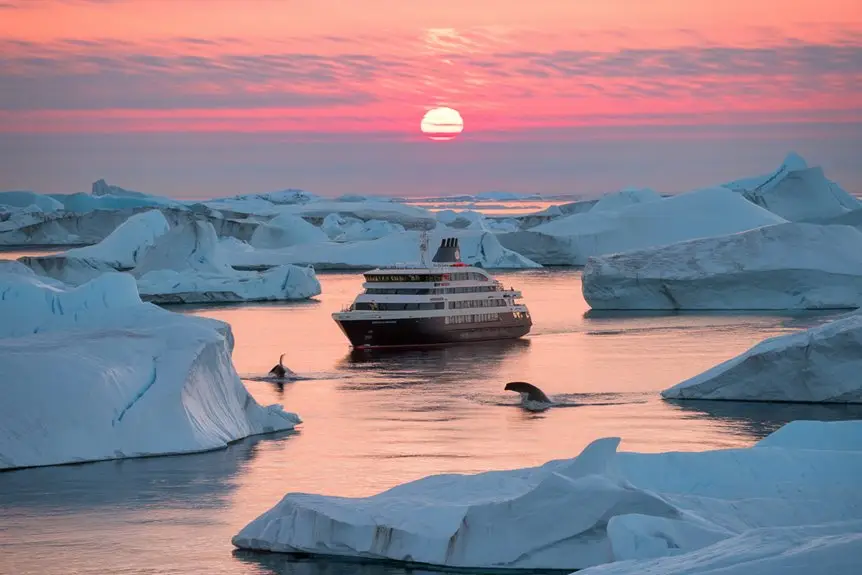Want to cruise the polar regions? Head there in their summer months. For Arctic trips, go between June and July when it’s about 0-10°C and you’ll see loads of polar bears and migrating whales under the never-setting sun.
Antarctica is brilliant from November to March, with up to 20 hours of daylight and temperatures hovering between -7 and 2°C – brilliant timing to watch penguins nesting and whales leaping about.
Both regions have their own special wildlife and weather patterns, making each worth a proper look.
🐧 Polar Cruise Enquiry 🐻❄️
Our team of polar travel specialists have personally explored both the Arctic and Antarctic regions – from tracking polar bears in Svalbard to kayaking with penguins off the Antarctic Peninsula. Let us find the right polar expedition cruise for you.
Key Takeaways
- You’ll find Arctic cruises are busiest in June-July when the sun never sets, temps hover between 0-10°C, and you’re most likely to spot polar bears and whales.
- For Antarctic cruises, November-March is your best bet, with loads of daylight and brilliant chances to watch penguins nesting and whales passing through.
- If you’re keen to see wildlife, especially polar bears lounging about on ice floes in Svalbard, head out early in the morning.
- The weather plays a massive role in how safely ships can move about – Arctic summers tend to be quite wet, whilst Antarctica stays rather dry.
- During polar summers, you can keep going well into the evening – fancy a bit of kayaking amongst the icebergs at 9 PM? The endless daylight makes it possible.
Polar Cruise Weather Guide

The weather has a big impact on polar cruising – it affects everything from seeing wildlife to going ashore.
In the Arctic summer, you’ll find temperatures between 32-50°F (0-10°C), whilst Antarctic summers are cooler at 20-35°F (-6 to 2°C). If you travel during the seasons just before or after peak times, it’s colder but you might see more wildlife.
Wind is a major factor on your cruise, and it can blow up to 25-30 knots. You’ll want to be ready for different types of weather – the Arctic summer tends to be rainy, but Antarctica stays quite dry.
The amount of daylight varies hugely too: the Arctic has round-the-clock sun in peak summer (June-July), while Antarctic sailing season (November-March) gives you 18-24 hours of daylight.
All these conditions determine when ships can safely sail through icy waters.
Polar Cruise Wildlife Seasons

When you’re planning a polar cruise, picking the right season makes a huge difference in seeing wildlife. Up in the Arctic, polar bears are most active from June to July, whilst whales pop up in the waters from July to August.
Arctic foxes and seabirds are everywhere during the summer breeding season from May to June.
If you fancy an Antarctic cruise, you’ll see different creatures throughout the southern summer. You can watch penguins building their nests in November, spot whales moving through from December to February, and see seals having their pups in December.
Late February to March gives you the best chance to see orca pods on the hunt. During this time, you’ll also catch baby penguins learning to swim, which makes for brilliant wildlife viewing near the shore.
Polar Cruise Activity Timing

The timing of polar activities depends on daylight and ice conditions. In summer, you’ll get loads of daylight, with the Arctic giving you midnight sun and Antarctica up to 20 hours of light.
All this brightness means more time to explore and snap brilliant wildlife photos.
- See polar bears hunting on ice floes in the early morning during June in Svalbard
- Go kayaking through Antarctic waters at 9 PM while the sun still lights up massive icebergs
- Take photos of penguins during golden hour, which can stretch on for hours in December
- Watch whales leaping against the pink-tinged sky during long Arctic twilight
Sort your daily outings around these prime light times, but stay flexible – weather and ice conditions can change quickly.
Frequently Asked Questions
What Medications Should I Pack for Seasickness During a Polar Cruise?
Worried about getting seasick? Pack some Dramamine, Bonine or scopolamine patches. You might also want to try ginger tablets and acupressure bands – they’re natural options that can help settle your stomach.
Are Single Cabins More Expensive on Polar Cruises Than Shared Accommodation?
You’ll generally need to fork out more money for a single cabin compared to shared rooms on polar cruises – solo travellers usually pay between 50-100% extra on top of the normal per-person shared cabin rate.
How Much Crew-Passenger Interaction Can I Expect During the Voyage?
It’s up to you – you’ll have lots of chances to chat with crew members during mealtimes, talks, zodiac trips and as you go about your day aboard the polar cruise.
Do Polar Cruise Ships Have Reliable Internet and Phone Connectivity?
You’ll get patchy connections in polar areas. Most ships have satellite internet and phone service, but it’s rather slow, pricey and can be a bit dodgy due to being in the middle of nowhere.
What Fitness Level Is Required for Most Polar Cruise Excursions?
You’ll want a decent level of fitness for most polar trips. Best if you can walk around 1-2 miles, handle stairs, hop in and out of Zodiacs, and feel steady on rough ground.
🐧 Polar Cruise Enquiry 🐻❄️
Our team of polar travel specialists have personally explored both the Arctic and Antarctic regions – from tracking polar bears in Svalbard to kayaking with penguins off the Antarctic Peninsula. Let us find the right polar expedition cruise for you.
